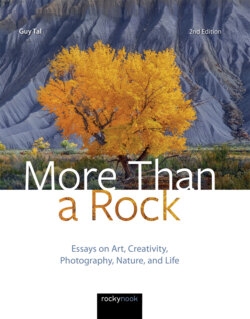Читать книгу More Than a Rock, 2nd Edition - Guy Tal - Страница 7
На сайте Литреса книга снята с продажи.
Preface
ОглавлениеThis then: to photograph a rock, have it look like a rock, but be more than a rock.
—Edward Weston
In our time, photography of natural landscapes is generally aimed at showcasing the inherent, objective aesthetics of natural scenes and subjects, interesting geographic features, majestic feats of light, and other naturally occurring phenomena. The idea of images as metaphors rather than literal depictions—although well established in painting and other visual arts—is often a revelation to photographers, and one I emphasize in my teaching and writing.
The above quotation by photographer Edward Weston is one I mention frequently as a means of distinguishing creative photography from representational photography. Creativity, by common definition, is the production of things both novel and useful; whereas representation in photography, quite literally, is the re-presenting of something already in existence.
In the context of photography, therefore, representation is accomplished primarily through technology, skill, and a fortuitous convergence of “right” places and “right” times. Creativity requires something beyond objective qualities inherent in objects, tools, or circumstances—something subjective that would not have existed had the photographer not created it.
To use Weston’s example, a representational image may portray a rock, which might be interesting in its own right. A creative image, on the other hand, must communicate more than just the likeness of a rock, even if a rock is all that is in the frame. Put another way, in creative photography the object is not the subject. Creative and representational photography both require degrees of skill, and both may yield works of great aesthetic appeal. Still, I believe that the pervasive and common failure to distinguish between the two is a severe handicap to the acceptance of photography as an artistic medium, on equal footing with painting, sculpture, music, or any others.
Where most people have no problem distinguishing abstract painting from technical illustration, or poetry from a news report—and applying different modes of appreciation to each—many people still perceive photography as a single category, to be judged by only one set of criteria (most often including fidelity to the original view) and lacking further distinction among genres, styles, and intents.
In this collection of essays I share some of my thoughts and experiences as one who seeks to express more in images than the mere appearances of the things portrayed.
Guy Tal
Torrey, Utah
